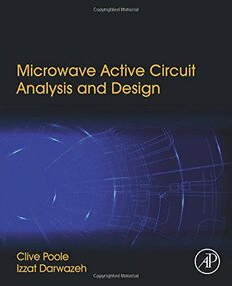Table Of ContentMicrowave Active
Circuit Analysis and
Design
Microwave Active
Circuit Analysis and
Design
Clive Poole
Izzat Darwazeh
DepartmentofElectronicandElectricalEngineering
UniversityCollegeLondon
AMSTERDAM (cid:129) BOSTON (cid:129) HEIDELBERG (cid:129) LONDON
NEW YORK (cid:129) OXFORD (cid:129) PARIS (cid:129) SAN DIEGO
SAN FRANCISCO (cid:129) SINGAPORE (cid:129) SYDNEY (cid:129) TOKYO
Academic Press is an imprint of Elsevier
AcademicPressisanimprintofElsevier
125LondonWall,London,EC2Y5AS,UK
525BStreet,Suite1800,SanDiego,CA92101-4495,USA
225WymanStreet,Waltham,MA02451,USA
TheBoulevard,LangfordLane,Kidlington,OxfordOX51GB,UK
©2016ElsevierLtd.Allrightsreserved.
Nopartofthispublicationmaybereproducedortransmittedinanyformorbyanymeans,electronicor
mechanical,includingphotocopying,recording,oranyinformationstorageandretrievalsystem,without
permissioninwritingfromthepublisher.Detailsonhowtoseekpermission,furtherinformationaboutthe
Publisher’spermissionspoliciesandourarrangementswithorganizationssuchastheCopyrightClearanceCenter
andtheCopyrightLicensingAgency,canbefoundatourwebsite:www.elsevier.com/permissions.
ThisbookandtheindividualcontributionscontainedinitareprotectedundercopyrightbythePublisher(other
thanasmaybenotedherein).
Notices
Knowledgeandbestpracticeinthisfieldareconstantlychanging.Asnewresearchandexperiencebroadenour
understanding,changesinresearchmethods,professionalpractices,ormedicaltreatmentmaybecomenecessary.
Practitionersandresearchersmustalwaysrelyontheirownexperienceandknowledgeinevaluatingandusing
anyinformation,methods,compounds,orexperimentsdescribedherein.Inusingsuchinformationormethods
theyshouldbemindfuloftheirownsafetyandthesafetyofothers,includingpartiesforwhomtheyhavea
professionalresponsibility.
Tothefullestextentofthelaw,neitherthePublishernortheauthors,contributors,oreditors,assumeanyliability
foranyinjuryand/ordamagetopersonsorpropertyasamatterofproductsliability,negligenceorotherwise,or
fromanyuseoroperationofanymethods,products,instructions,orideascontainedinthematerialherein.
LibraryofCongressCataloging-in-PublicationData
AcatalogrecordforthisbookisavailablefromtheLibraryofCongress
BritishLibraryCataloguinginPublicationData
AcataloguerecordforthisbookisavailablefromtheBritishLibrary
ForinformationonallAcademicPresspublications
visitourwebsiteathttp://store.elsevier.com/
PrintedintheUnitedStatesofAmerica
ISBN:978-0-12-407823-9
Contents
Preface.................................................................................................xv
Acknowledgments................................................................................xvii
Listofsymbolsandabbreviations.............................................................xix
Abouttheauthors................................................................................xxiii
SECTION A FOUNDATIONS 1
CHAPTER 1 Introduction..................................................3
IntendedLearningOutcomes................................................4
1.1 IntroductiontoMicrowaveElectronics...................................4
1.1.1 WhatAreMicrowaves?...............................................4
1.1.2 TheImportanceofRadioFrequencyElectronics...............6
1.1.3 ElectromagnetismBasics.............................................7
1.2 PropertiesofMaterialsatMicrowaveFrequencies...................12
1.2.1 Resistivity..............................................................13
1.2.2 TheSkinEffect.......................................................15
1.2.3 PermittivityandPermeability.....................................16
1.2.4 LossesinDielectricandMagneticMaterialsat
MicrowaveFrequencies.............................................18
1.3 BehaviorofRealComponentsatMicrowaveFrequencies.........20
1.3.1 Wire......................................................................20
1.3.2 Resistors................................................................21
1.3.3 Capacitors..............................................................23
1.3.4 Inductors................................................................25
1.3.5 SurfaceMountDevices.............................................27
1.4 TheImportanceofImpedanceMatching...............................28
1.4.1 MaximumPowerTransfer..........................................28
1.5 CommonMicrowaveMetrics..............................................31
1.5.1 ReflectionCoefficient...............................................31
1.5.2 StandingWaveRatio(SWR)......................................32
1.5.3 ReturnLoss............................................................33
1.6 QualityFactor,Q.............................................................34
1.6.1 TheMeaningofQ....................................................34
1.6.2 LoadedQandExternalQ..........................................40
1.6.3 QofaOne-PortResonator.........................................41
1.7 Takeaways......................................................................46
TutorialProblems.............................................................47
References......................................................................48
v
vi Contents
CHAPTER 2 Transmission Line Theory ............................... 51
IntendedLearningOutcomes..............................................51
2.1 Introduction....................................................................52
2.2 PropagationandReflectiononaTransmissionLine.................54
2.3 SinusoidalSteady-StateConditions:StandingWaves...............63
2.4 PrimaryLineConstants.....................................................68
2.5 TheLosslessTransmissionLine..........................................71
2.6 DerivationoftheCharacteristicImpedance............................72
2.7 TransmissionLinesWithArbitraryTerminations....................74
2.7.1 InputImpedanceatanArbitraryPointonaTerminated
Line......................................................................76
2.7.2 SpecialCases:Short-CircuitLine................................78
2.7.3 SpecialCases:Open-CircuitLine................................80
2.7.4 SpecialCases:MatchedLine......................................81
2.8 TheEffectofLineLosses..................................................81
2.8.1 CharacteristicImpedanceofLossyLines......................81
2.8.2 Dispersion..............................................................82
2.9 PowerConsiderations........................................................83
2.10 Takeaways......................................................................85
TutorialProblems.............................................................86
References......................................................................87
CHAPTER 3 Practical Transmission Lines........................... 89
IntendedLearningOutcomes..............................................89
3.1 Introduction....................................................................90
3.2 Waveguide......................................................................90
3.3 Co-AxialCable................................................................95
3.4 TwistedPair....................................................................98
3.5 Microstrip......................................................................99
3.6 MicrostripDiscontinuities................................................105
3.6.1 EdgeEffectsinMicrostrip........................................105
3.6.2 MicrostripGapsandDCBlocks................................106
3.6.3 MicrostripBendsandCurves....................................108
3.6.4 MicrostripStepWidthChange..................................110
3.7 Stripline.......................................................................111
3.8 CoplanarWaveguide.......................................................112
3.9 Takeaways....................................................................114
TutorialProblems...........................................................116
References....................................................................117
Contents vii
CHAPTER 4 The Smith Chart..........................................121
IntendedLearningOutcomes............................................121
4.1 IntroductiontotheSmithChart..........................................122
4.2 SmithChartDerivation....................................................122
4.2.1 DerivationofConstantResistanceCircles....................124
4.2.2 DerivationofConstantReactanceCircles....................126
4.2.3 BuildingtheCompleteSmithChart............................127
4.3 UsingtheSmithChart.....................................................131
4.3.1 ConversionBetweenImmittanceandReflection
Coefficient............................................................131
4.3.2 ImpedanceatAnyPointonaTransmissionLine...........133
4.3.3 ConstantQContoursontheSmithChart.....................134
4.4 SmithChartVariants.......................................................135
4.4.1 CombinedImpedance-AdmittanceSmithChart.............135
4.4.2 CompressedSmithChart..........................................137
4.5 Takeaways....................................................................137
TutorialProblems...........................................................138
References....................................................................140
SECTION B MICROWAVE CIRCUIT ANALYSIS 141
CHAPTER 5 Immittance Parameters.................................143
IntendedLearningOutcomes............................................143
5.1 Introduction..................................................................144
5.1.1 TheAdmittanceorY-Parameters...............................145
5.1.2 TheImpedanceorZ-Parameters................................146
5.1.3 TheHybridorh-Parameters......................................149
5.1.4 TheChainorABCD-Parameters................................150
5.2 ConversionBetweenImmittanceParameters........................152
5.3 Input and Output Impedance of a Two-Port in Terms of
ImmittanceParameters....................................................153
5.4 ClassificationofImmittanceMatrices.................................155
5.4.1 ActivityandPassivity..............................................155
5.4.2 Unilaterality..........................................................158
5.4.3 ReciprocityandSymmetry.......................................158
5.5 ImmittanceParameterRepresentationofActiveDevices.........159
5.5.1 Two-PortRepresentationofTransistors.......................159
5.6 ImmittanceParameterAnalysisofTwo-PortsWithFeedback...161
5.6.1 TheBenefitsofFeedback.........................................161
5.6.2 ShuntFeedback.....................................................161
viii Contents
5.6.3 SeriesFeedback.....................................................161
5.6.4 Miller’sTheorem...................................................162
5.7 Takeaways....................................................................164
TutorialProblems...........................................................164
References....................................................................166
CHAPTER 6 S-Parameters.............................................167
IntendedLearningOutcomes............................................168
6.1 Introduction..................................................................168
6.1.1 LimitationsoftheImmittanceParameterApproach........169
6.1.2 DefinitionoftheScatteringParameters.......................170
6.2 InputandOutputImpedanceofaTwo-PortinTermsof
S-Parameters.................................................................174
6.3 ClassificationofS-Matrices..............................................175
6.3.1 LosslessandReciprocalNetworks.............................175
6.3.2 ActivityandPassivity..............................................176
6.3.3 Unilaterality..........................................................180
6.4 SignalFlowGraphs.........................................................180
6.4.1 DecompositionofSignalFlowGraphs........................181
6.5 ScatteringTransferParameters..........................................187
6.6 RelationshipBetweenS-Parametersand
ImmittanceParameters....................................................190
6.7 MeasurementofS-Parameters...........................................191
6.7.1 TheNetworkAnalyzer............................................193
6.7.2 VNAMeasurementProcedure...................................195
6.7.3 NetworkAnalyzerErrorCorrection............................195
6.7.4 One-PortErrorModel(The“Three-Term”Model).........196
6.7.5 Two-PortErrorModel(The“12-Term”Model).............199
6.8 Takeaways....................................................................201
TutorialProblems...........................................................202
References....................................................................204
CHAPTER 7 Gain and Stability of Active Networks................205
IntendedLearningOutcomes............................................205
7.1 Introduction..................................................................206
7.2 PowerGaininTermsofImmittanceParameters....................206
7.2.1 VoltageGainofanActiveTwo-Port...........................206
7.2.2 PowerGainofanActiveTwo-Port.............................207
7.3 StabilityinTermsofImmittanceParameters.........................215
7.4 StabilityinTermsofS-Parameters......................................217
7.4.1 Introduction..........................................................217
Contents ix
7.4.2 StabilityCircles.....................................................217
7.4.3 StabilityCriteriainTermsofS-Parameters...................224
7.5 PowerGaininTermsofS-Parameters.................................229
7.5.1 MaximumAvailableGainandConjugate
Terminations.........................................................235
7.5.2 ConstantPowerGainCircles....................................238
7.6 Takeaways....................................................................241
TutorialProblems...........................................................242
References....................................................................243
CHAPTER 8 Three-Port Analysis Techniques.......................245
IntendedLearningOutcomes............................................245
8.1 Introduction..................................................................246
8.2 Three-PortImmittanceParameters.....................................247
8.3 Three-PortS-Parameters..................................................249
8.3.1 DerivationofThree-PortS-Parameters........................250
8.3.2 CalculationofReducedTwo-PortS-Parameters............257
8.4 ConfigurationConversion.................................................259
8.4.1 CommonBase/GateConfiguration.............................260
8.4.2 CommonCollector/DrainConfiguration......................260
8.5 FeedbackMappings........................................................261
8.5.1 Introduction..........................................................261
8.5.2 ClassificationofFeedbackMappings..........................266
8.6 ApplicationofThree-PortDesignTechniques.......................271
8.6.1 GeneratingNegativeResistanceinTransistors..............271
8.6.2 TheActiveIsolator.................................................275
8.7 ReverseFeedbackMappings.............................................278
8.8 Takeaways....................................................................281
TutorialProblems...........................................................281
References....................................................................282
CHAPTER 9 Lumped Element Matching Networks.................285
IntendedLearningOutcomes............................................285
9.1 Introduction..................................................................286
9.1.1 TheNeedforImpedanceMatching............................286
9.2 L-SectionMatchingNetworks...........................................287
9.2.1 L-SectionMatchingofaResistiveSourcetoaResistive
Load....................................................................287
9.2.2 GeneralizedAnalyticalDesignofType1L-Section.......291
9.2.3 GeneralizedAnalyticalDesignofType2L-Section.......292
9.2.4 L-SectionDesignUsingtheSmithChart.....................293

